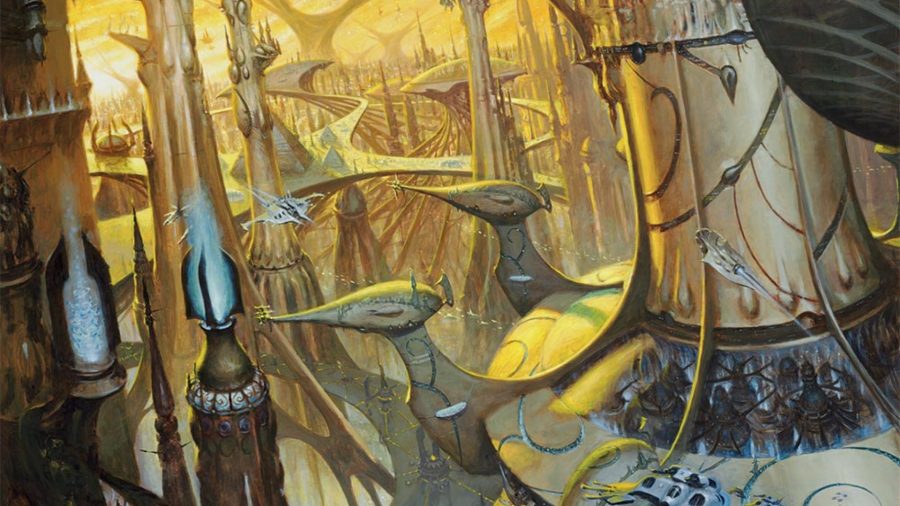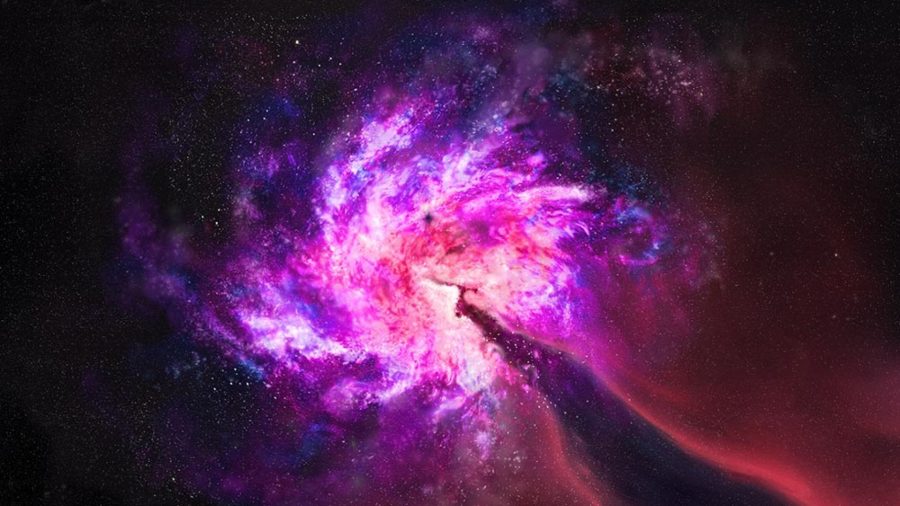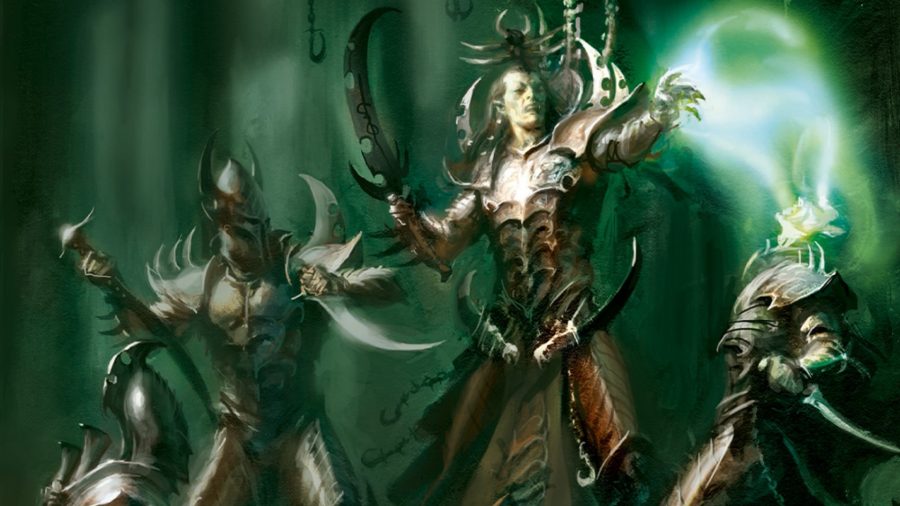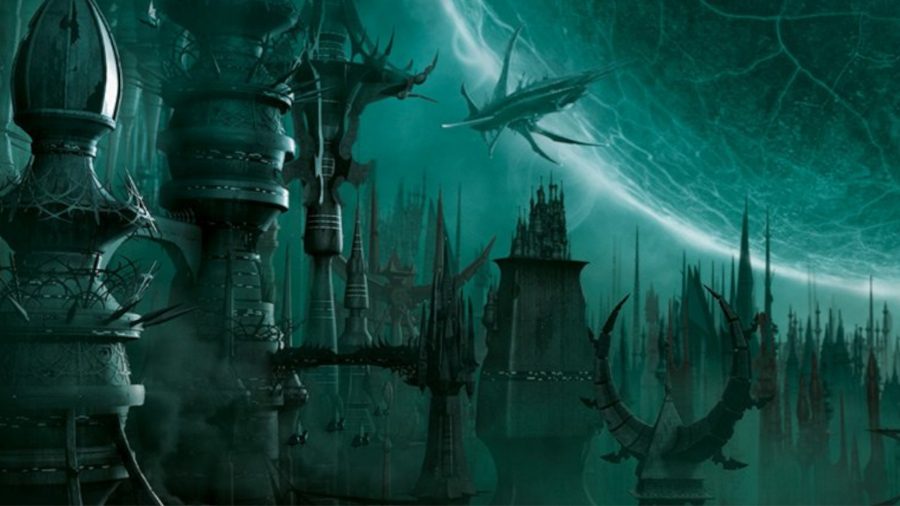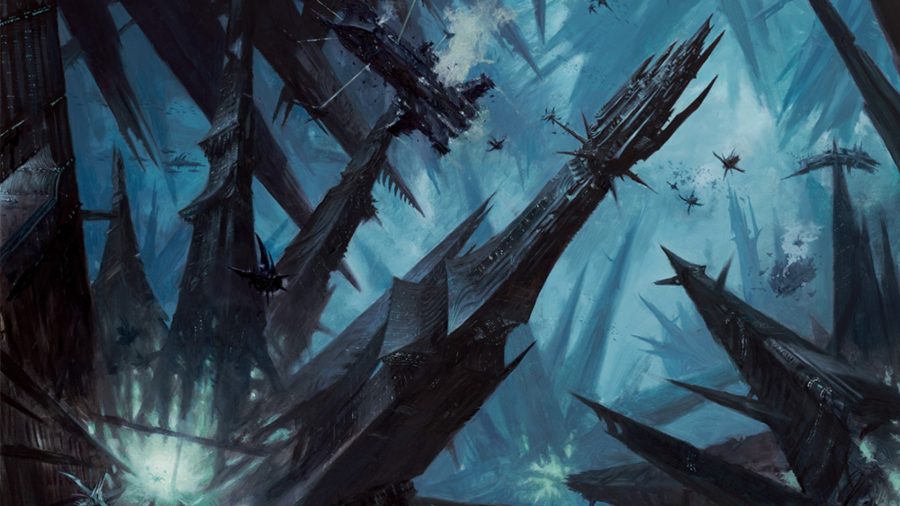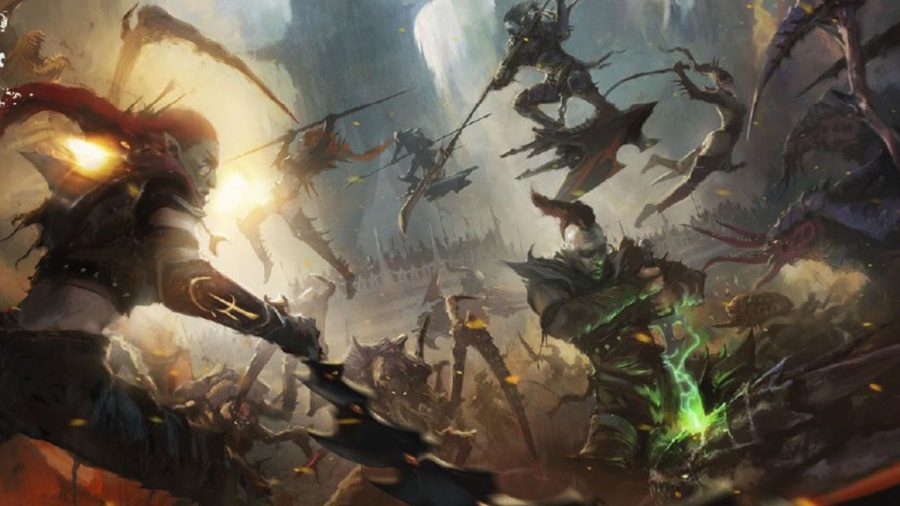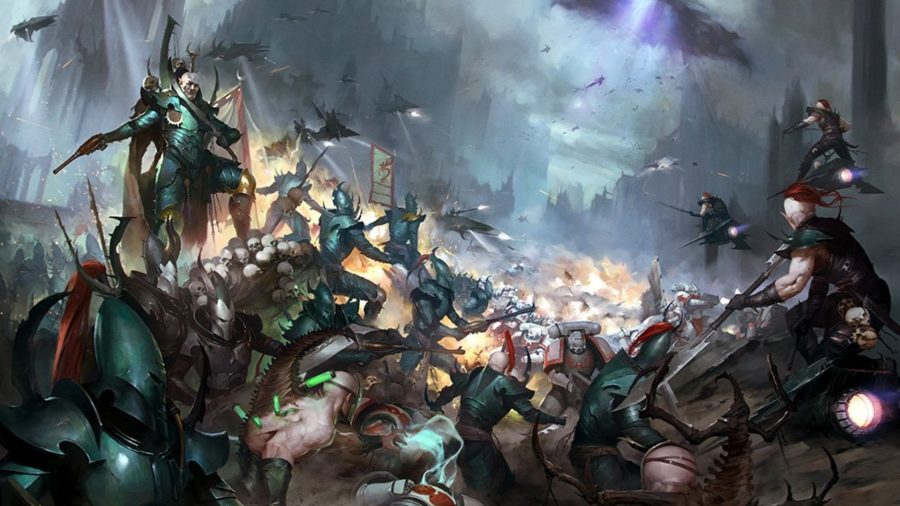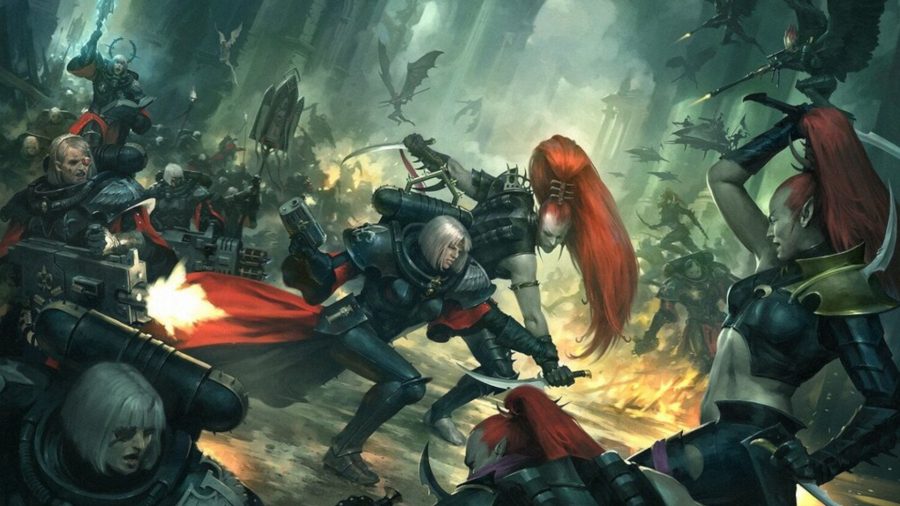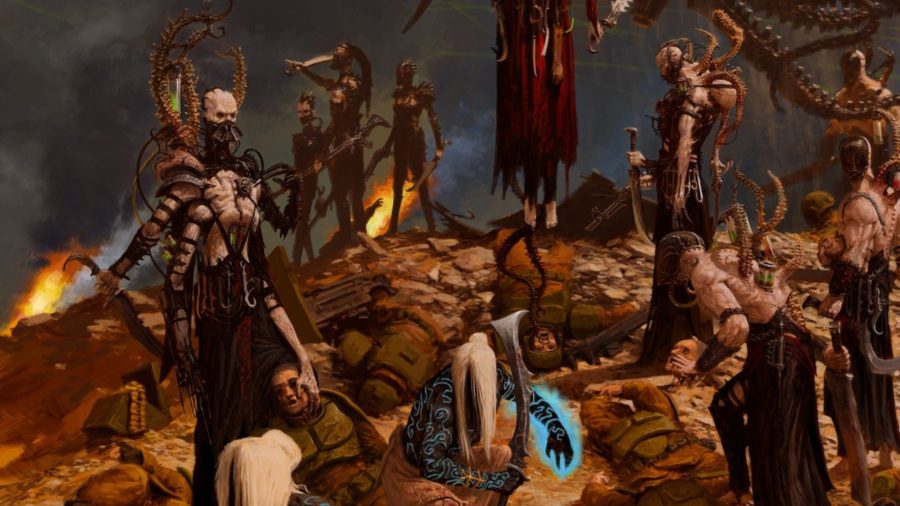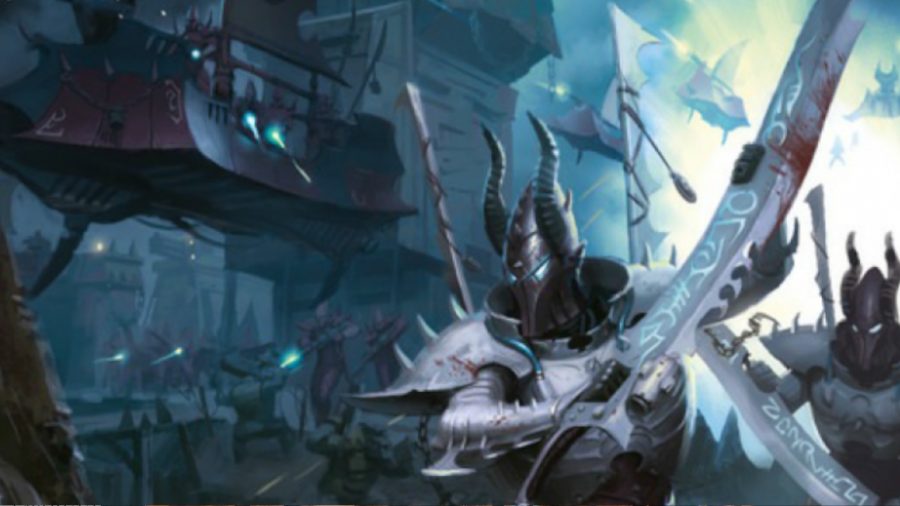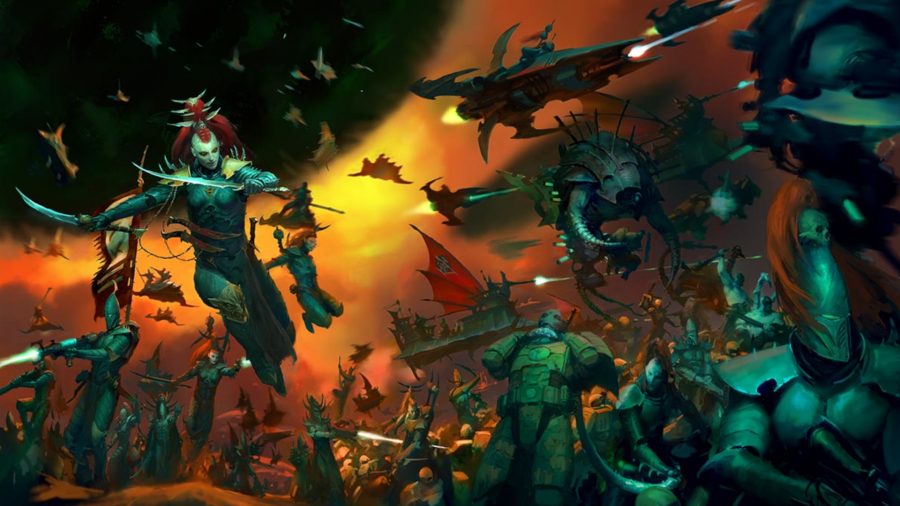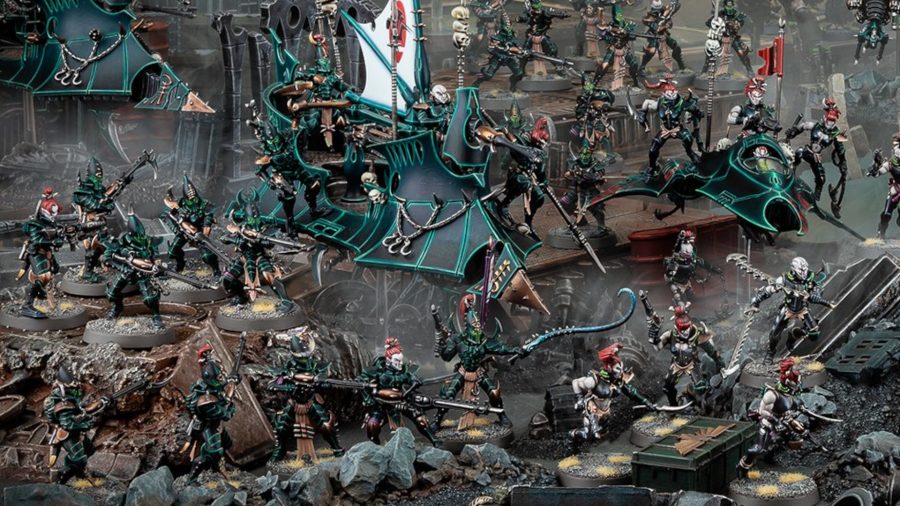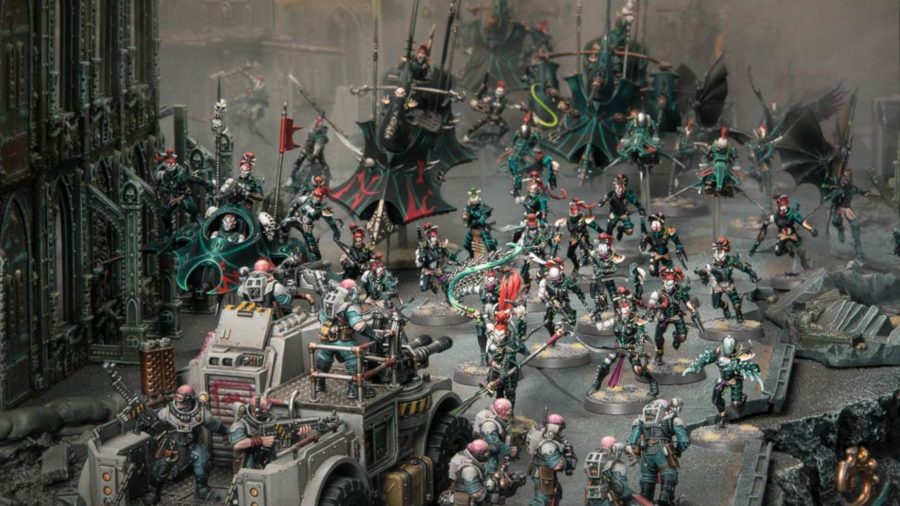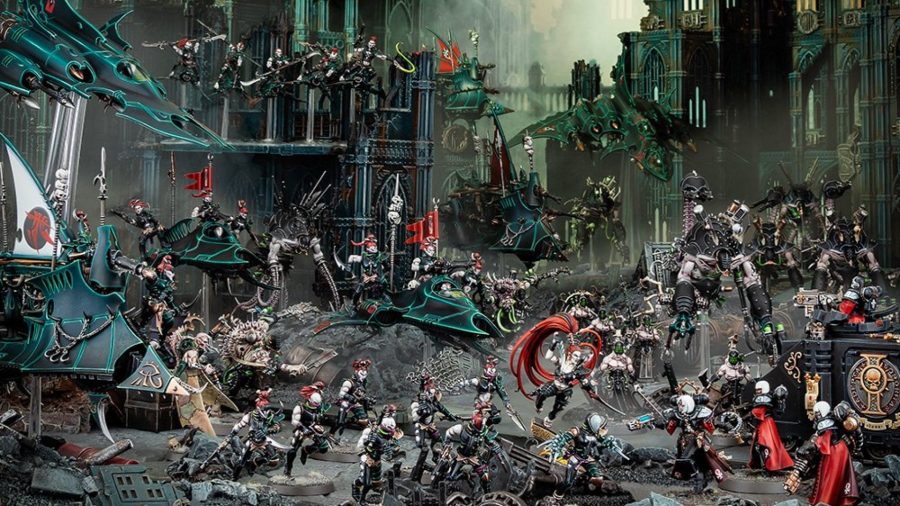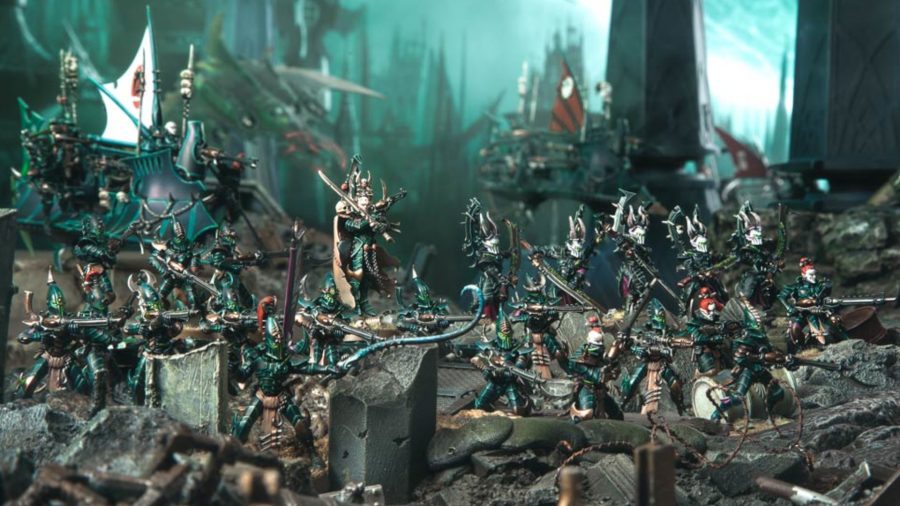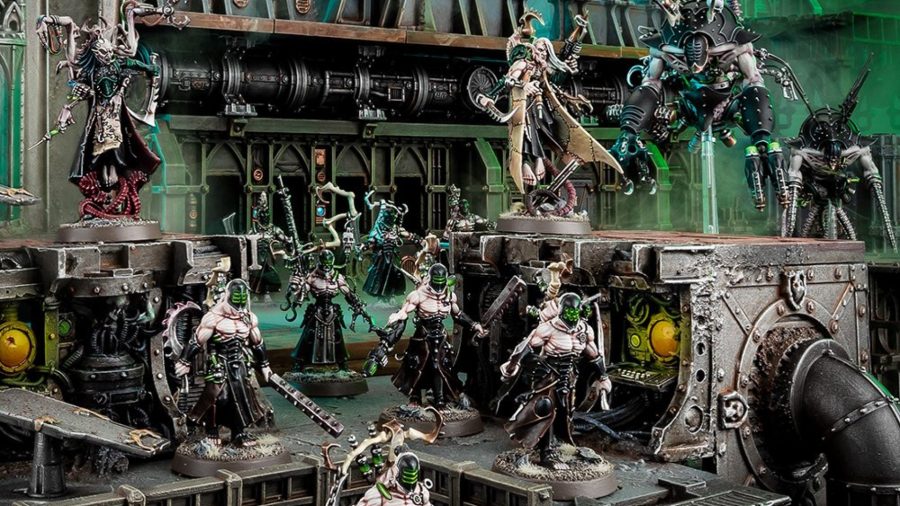Pray that Warhammer 40k’s Drukhari do not take you alive. Black-hearted raiders, bloodthirsty gladiators, and sculptors of flesh, the Drukhari are a twisted reflection of the Craftworld Aeldari. While their nobler kin chose a life of discipline and duty to stave off the threat of Slaanesh, the Drukhari walk a darker, more depraved path.
Revelling in torture, slavery, and piracy, the Drukhari are a race of sadists who use the suffering of other, lesser, races to save their own souls. With their entire society built around cruelty and pain, the Dark Kin use their knowledge of the Webway to launch lightning-fast raids into Realspace. In the grimdark Warhammer 40,000 galaxy, full of fates worse than death, there are few things worse than the threat of being captured by the Drukhari.
On the tabletop, the Drukhari use their incredible speed, advanced poison technology, and incredible tactical flexibility to overwhelm their foes. 9th Edition Warhammer 40k has been particularly good to this race of unrepentant monsters, so you might be wondering: where to start with the Drukhari?
Well, let’s start with the story of how the Dark Kin came to be, which began a long time ago, before the birth of Slaanesh.
Drukhari lore – The coming of Slaanesh
Tens of thousands of years before the arrival of the Emperor and his legions of Space Marines, the Aeldari – also called Eldar – ruled the cosmos. It was a golden age for the Eldar, whose advanced technology and incredible psychic might gave them dominion over the galaxy. No feat of empire, technology, or culture was beyond them, and their mastery over the Webway – a labyrinthine network of tunnels through the skin that divides Realspace and the Warp – allowed them to expand their realm even to the most far-flung corners of the galaxy.
The most depraved Eldar found a new home in the Webway, before the empire fell
Yet within the heart of the Empire, a psychic cancer was growing, and the arrogance of the Aeldari blinded them to their doom. For you see, with their advanced technology, there was no need for the Aeldari to toil in the field or labour under the sun. Instead, machines did the work, which freed the Eldar to indulge in all the pleasures the galaxy had to offer. Over time, cults of pleasure started to form as the Aeldari pursued new and more esoteric forms of sensation, and the Empire began to collapse into decadence. Some of the pleasure cults – the ones that had pushed the boundaries too far even for the hedonistic Eldar – retreated into the Webway where they found a new home in the depths of Commorragh, a port city, hidden deep in the passages of subspace. Commorragh’s streets soon ran with blood as pirates, raiders, and those deemed too extreme for normal Aeldari society flocked to this wretched hive of scum and villainy.
Meanwhile, in the Empire, the orgy of decadence reached its crescendo and, in one sudden, fantastic cataclysm, powered by the latent psychic abilities that all Aeldari share, a new god was born. Slaanesh, She Who Thirsts, tore through the skin of reality and let out a scream that flayed the Empire to its bones. Billions of Aeldari died, their souls consumed by Slaanesh, as Realspace was rent open, and the now infamous Eye of Terror formed in what had been the heart of the once-mighty Empire.
Shadow in the Warp: Read our Warhammer 40k Tyranids guide
Those Eldar who’d hidden away inside the Webway survived the psychic apocalypse – but found themselves changed. While the Webway had offered some protection from Slaanesh, the newly formed Chaos God still had a claim on their souls, and the Aeldari living in Commorragh soon began to find themselves diminished. That is, until they realised that they could substitute the suffering of others for their own, drawing power from the pain they inflicted – and thus their sadistic society was born.
The rise of Asdrubael Vect
For millennia after, the highborn of Commorragh sent raiders and pirates into Realspace, to kidnap victims and drag them back to the dark city. These unfortunate souls would then suffer untold tortures as a way to stave off the ‘dark’ Eldar’s own damnation, or else be kept as slaves in the houses of idle Aeldari nobility.
Vect plotted to overthrow the dominant Kabals and rule the dark city
One such slave was an Aeldari named Asdrubael Vect, the being who would come to define this new society and give them the name Drukhari. Born a commoner, Vect was sold into slavery as a young child, which gave him an eternal hatred for the nobility who ruled over the city, and he swore that he would one day rule Commorragh.
As he grew, he used his sharp mind (and even sharper blade) to found the Kabal of the Black Heart, a militaristic group who opposed the city’s aristocratic rulers. A cautious individual, Vect knew he stood no chance against the combined might of Commorragh’s ruling houses in a direct confrontation, and so he plotted a more duplicitous scheme to rid the city of his old enemies.
Vect and his Kabal began to deliberately target the Imperium of Man’s shipping lanes and increased the frequency of attacks against humanity, in the hope that his aggressive attacks would provoke the Imperium into retaliating. The Archon of the Black Heart got his wish, and a strike cruiser of Salamanders Space Marines was dispatched to deal with the raids.
Sons of Prospero: Read our Warhammer 40k Thousand Sons guide
Using specialised ‘Haywire’ anti-vehicle weapons, Vect managed to cripple the cruiser and drag it back to the Dark City, where he gifted the ship to the old Aeldari nobility.
Greedy for more souls to torture, the nobles threw caution to the wind and accepted the gift – but soon came to regret their avarice. The Adeptus Astartes on board had managed to contact their chapter, and soon the full might of the Salamanders Chapter was brought to bear on the nobles of Commorragh.
Vect became the undisputed overlord of Commorragh
How this second Space Marine force found their way into the Webway is unknown, but many suspect Vect gave them safe passage into Commorragh. While the nobles’ own Kabals were eventually successful in repelling the Salamanders, they found themselves drastically weakened as a result – and finally Vect and his Black Heart warriors stepped in to fill the void. Over the next few millennia, through guile, diplomacy, and bloodshed, Vect reforged the Aeldari of the Webway into the Drukhari and became the undisputed overlord of Commorragh.
Drukhari subfactions – Kabals, Covens, and Cults
While the Drukhari are a powerful and satisfying army to play with and against (but especially with), they have a unique, complex, and fiddly army composition – and as such, newcomers to Warhammer 40k should be wary. Much of the complexity comes in managing the Drukhari’s three distinct subfactions: Kabals, Haemonculus Covens, and Wych Cults.
Each subfaction has access to its own unique HQ and Troops units, Relics, and subfaction traits called ‘Obsessions’. You can’t mix the subfactions within a single detachment, or you lose those special rules.
Mighty machines: Our Warhammer 40k Imperial Knights guide
You can, however, spend some CP to make your army a ‘Realspace Raid‘, which – with some conditions – allows you to use several detachments from the different factions all at once, and still keep your special bonuses.
But that’s not all, Dark Eldar fans! Beyond the three main subfactions, Drukhari armies can field a strange menagerie of extra mercenaries called ‘Blades for Hire’. Not to worry; we’ll cover each of these groups in turn:
Kabals
The backbone of what passes for society in Commorragh, the Kabals range from gangs of petty thugs to the gigantic Black Heart armies of Asdrubael Vect. Deadly Archons lead swathes of Kabalite Warriors out into Realspace to inflict suffering on the galaxy, and bring slaves back to Commorragh. On the tabletop, the Kabalites are the Drukhari’s more shooting focused sub-faction, and work best at medium range, picking off enemies with their poison splinter rifles and swingy but powerful special weapons.
Wych Cults
The Wych Cults of Commorragh are highly celebrated, drug-enhanced, acrobatic artists of death. Led by the crazed Succubi, they live their lives in gladiatorial combat and excel in melee. On the table, they serve as terrifying assault squads, slicing and dicing through opponents like they’re made of butter.
Haemonculus Covens
Then we have the weirdest sub-faction, the Haemonculus Covens. Perverted scientists, the Cults are led by twisted, hideous Haemonculi, who conduct bizarre experiments on slaves and their own kin alike, in an effort to explore the outer reaches of sensation. In combat, these flesh-crafters serve best as tanks, their pallid skin shrugging off even the deadliest of attacks like they’re nothing.
Blades for Hire
Finally, there’s the odd ones out, the Blades for Hire. These are the units outside the strict hierarchy of Commoragh’s culture: the Incubi, Scourges, and Mandrakes. They don’t belong to any of the sub-factions and, as such, don’t benefit from their special rules – but nor do they disqualify your other troops from benefiting from their Obsessions.
Drukhari tactics – Strengths
9th Edition has made the Drukhari into one of the strongest armies in the game, and the faction boasts a number of strengths that make them a nightmare for unwary opposing generals.
The Drukhari’s first and most obvious strength is speed
The first and most obvious strength is their speed. In Warhammer 40k lore, the Drukhari are known for their rapid assaults, and that translates directly to the tabletop. Thanks to their highly mobile, cheap transports, the Drukhari excel at alpha strikes – getting up in an opponent’s face before they know what to do, and causing a lot of hurt, very quickly. All three of the sub-factions boast some incredibly cheap troop options as well. Kabalite Warriors can make mincemeat of durable enemies regardless of their toughness, thanks to their poison weapons. They also enjoy a whole host of special weapon options that make them a super flexible unit.
Wyches are one of the deadliest melee units in the game, capable of tossing out dozens of strength 4 attacks with the right combo in play. In close combat, they also enjoy a 4+ invulnerable save, making them a challenge to remove from the battlefield, once they’ve got up close and personal.
First rank, fire! Read our Warhammer 40k Astra Militarum guide
Then we have the Haemonculus Covens’ Wracks. While not the indestructible monsters they were in 8th edition, Wracks are a great, hardy option for securing objectives that’ll make your opponent work hard to wipe them out.
Being, effectively, three armies in one gives the Drukhari a tactical flexibility that other Xenos armies lack. While it can be tricky and Command Point-intensive to get all three sub-factions into a single list, the benefits of doing so are enormous. By combining the strengths of the three different sub-factions in a Realspace Raid army, you cover a number of their individual weaknesses.
Finally, the Drukhari all benefit from the ‘Power From Pain‘ special rule. This army-wide passive ability starts good, and just gets better as the game goes on. Basically, your whole army gains a new blanket buff each turn, reflecting your Drukhari troops getting progressively more powered up by all the suffering they’re dishing out on the battlefield.
Drukhari tactics – Weaknesses
While the Drukhari are a force to be reckoned with on the tabletop, they aren’t without their weaknesses. Drukhari, with the exception of Haemonculus Cults, are extremely fragile, with most troops having Toughness 3 and a paltry 5+ armour save (at best). To make matters worse, the Drukhari are best at middle to close range, so you can’t just castle up and sit at the back of the board like a T’au player.
This makes the Dark Kin extremely reliant on transports to get around the board and protect them from gunfire. Even then, though, one lightly armoured Raider is probably going to go down if you unwittingly place it too close to multiple shooting units.
Flesh and metal: Our Warhammer 40k Adeptus Mechanicus guide
The Drukhari also lack any real psychic defence. Unlike their Craftworld counterparts, the Drukhari let their psychic powers atrophy to avoid the gaze of Slaanesh. In gameplay terms, this means the army has no psykers of its own, and only one Relic that allows them to “Deny the Witch“. Clever use of allies can mitigate this weakness slightly, but changes in 9th edition’s ally rules have made this more difficult than it once was.
Finally, we need to talk about special characters. Once upon a time, the Drukhari codex was jam-packed with special characters, but over the years, the options have withered away. They don’t even have an option for Vect anymore. In 9th edition, they have but three choices: Lelith Hesperax, Urien Rakarth, and Drazhar. Of these three, only Drazhar has any real use on the tabletop, but the other two are still fun, fluffy options.
How to start collecting Drukhari
If you want to play Drukhari, you’re going to need to work out which of the three sub-factions you want to lead with. While you’ll inevitably end up using all three, we’d recommend that you start with your favourite, and slowly build out your force to include the others.
If you want to start a Kabal, your path is clear: you’re going to want to pick up the Drukhari Combat Patrol box. Easily one of the best patrol boxes Games Workshop has done, this comes with an Archon HQ, ten Kabalite Warriors, five Incubi, a Raider transport vehicle, and a Ravager heavy weapons platform. All are solid unit choices for any Archon wanting to learn the ropes; the Drukhari Combat Patrol gives you a solid base to start building out your army.
Starting a Wych Cult or a Haemonculus Coven is a slightly fiddlier affair. Neither of these sub-factions has their own starter box, so you’re going to have to buy everything individually, which can make collecting these armies a more expensive prospect. That said, if you wanted to get started with a Wych Cults force, we recommend starting with a box of Wyches, a Succubus HQ character, two Venom transports, and a squad of Reaver jetbikes.
Dynasties of death: Read our Warhammer 40k Necrons army guide
As for the Covens, of all the Drukhari sub-factions, they’re easily the most difficult to start collecting. Their basic troop choice, Wracks, only come in boxes of five, and you’re going to want at least 10 to get started. Not only that, one of the Covens’ best units, the Grotesque, doesn’t even have a plastic model at the time of writing. Still, if your dark heart is set on collecting the cruel artisans of flesh, then we recommend picking up two boxes of Wracks, two Venom transports, a Haemonculus HQ, and a Talos Pain Engine.
Source: Wargamer




